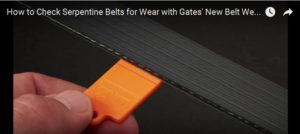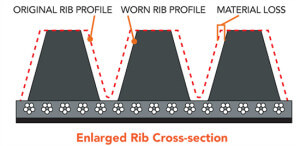How to check serpentine belt wear
Check serpentine belt wear
You can’t check serpentine belt wear visually anymore
Since 1995, most car makers started using ethylene propylene diene monomer (EPDM) rubber for their polygroove belts. Older polygroove belts were made from neoprene which cracked as it aged. To check serpentine belt wear on a neoprene multi-rib belt, you count the number of cracks in a single rib in a 3” section. If you see three or more cracks in that 3″ section of a single rib, that means the belt has gone beyond the 80% mark and it’s time to replace it. Neoprene belts wear out as quickly as 30M miles.
But EPDM is far more resistant to engine heat and cracking and can run without cracks to almost 100M miles. Unfortunately, you can’t determine if an EPDM belt is worn with a visual inspection.
How to measure wear on an EPDM serpentine belt
A polygroove belt wears just like older V-Belts. The only difference is that the V ribs are smaller and there are more of them. Each V-rib engages with the V-groove in the pulley. As the V-ribs wear, they ride lower in the pulley groove. This wear is similar to an old style V-belt. Since a polygroove belt has a backing, it’s the backing that turns the pulley when the individual V-ribs wear out.
The belt backing drives the pulley when the serpentine belt V-ribs wear out
Since the ribs no longer engage the grooves in the pulley, it’s only the belt backing that engages. The tensioner can apply more tension, but since the belt has far less surface area engaged with the pulley grooves, it slips. Simply put, an EPDM belt can look fine, but if the ribs are worn, the belt will slip.
To learn how to check an automatic belt tensioner, see this post
You must use a wear gauge to judge serpentine belt wear
This illustration shows how rib wear can cause the belt to  lose gripping power. The belt’s only contact with the pulley is at the bottom of the rib valley. It simply loses its ability to wedge into the pulley “V”. So the belt slips, chirps, squeals and the driven component loses efficiency.
lose gripping power. The belt’s only contact with the pulley is at the bottom of the rib valley. It simply loses its ability to wedge into the pulley “V”. So the belt slips, chirps, squeals and the driven component loses efficiency.

This illustration shows how rib wear can cause the belt to lose gripping power. The belt’s only contact with the pulley is at the bottom of the rib valley. It simply loses its ability to wedge into the pulley “V”. So the belt slips, chirps, squeals and the driven component loses efficiency.
The polygroove belt wear gauge measures how much rib material has worn away. Gates and Dayco offer belt gauges. Or, you can download a Gates app for your smartphone. To use it, take a picture of the belt and the app can measure belt wear for you.
When the gauge shows the belt wear exceeds tolerances, replace the belt
©, 2019 Rick Muscoplat
Posted on by Rick Muscoplat
